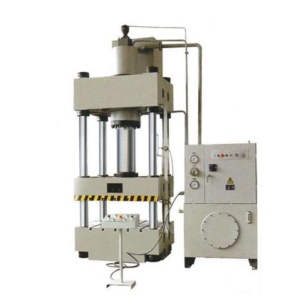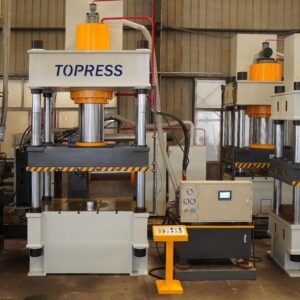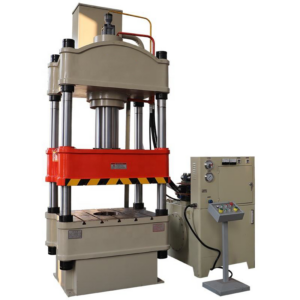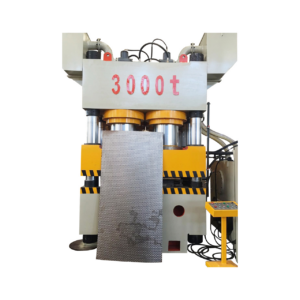Operating Principles and Types of Hydraulic Presses
Hydraulic presses operate based on Pascal’s law, which states that pressure in a confined fluid is uniformly transmitted. This principle allows hydraulic presses to convert mechanical energy into hydraulic energy, driving actuators and amplifying force. The force amplification follows the equation F1A1=F2A2\frac{F_1}{A_1} = \frac{F_2}{A_2}A1F1=A2F2, showing that the force is directly proportional to the piston area.

Modern hydraulic presses come in six primary structural types, each designed for specific tasks. Four-column presses use four pillars to support the frame, with hydraulic cylinders driving the movable crossbeam for high-pressure forging (35–100 MPa). These presses, which handle capacities ranging from 800 to 5000 metric tons, excel in stamping and powder compaction. C-frame presses offer three-sided accessibility for sheet metal bending but lack the rigidity of other presses. Frame-type presses, with integrated welded bodies and guide systems, maintain ±0.1mm precision under eccentric loads.
Horizontal presses apply lateral force, and they come with overload protection and speed-switching capabilities, making them versatile. Gantry presses feature height-adjustable worktables, ideal for handling large components. Specialized presses, such as powder presses using floating die technology and laminating presses with multi-heating plates, process powders and thermoset plastics with high efficiency.
Core Technology and Industrial Use
Hydraulic presses rely on three key systems for operation. The power unit, a motor-driven pump, converts mechanical energy into hydraulic energy. Actuators then distribute high-pressure oil to the cylinders, applying the necessary force. Finally, control systems regulate the press’s operations, ensuring smooth transitions through actions such as rapid approach, slow pressing, dwell, and return. Technologies like V-seal combinations, thermal management systems, and CNC integration improve both the precision and efficiency of hydraulic presses.
Hydraulic presses serve a wide range of industries. In automotive manufacturing, for example, four-column presses stamp body panels, while frame-type presses handle precision forging. In aerospace, 300MN die-forging presses produce titanium components, known for their excellent strength-to-weight ratio. In metal processing, presses exceeding 2000T are used to produce heavy-duty components like crankshafts, while horizontal presses extrude aluminum profiles, reducing component weight by up to 30%. In non-metal sectors, powder presses manufacture carbide tools, while laminating presses process thermoset plastics such as Bakelite switches used in electrical components.

Selection, Maintenance, and Trends
Choosing the right hydraulic press requires following established guidelines. High-voltage motors (10kV) power systems exceeding 500 tons, while frame-type presses are preferred for precision tasks. Maintenance includes monthly viscosity checks on hydraulic fluid, activating cooling systems when temperatures exceed 60°C, and replacing seals and cleaning filters, especially in dusty environments.
The future of hydraulic presses will likely focus on intelligent systems, such as predictive maintenance, which can reduce downtime and improve operational efficiency. Energy efficiency will become increasingly important, with servo systems reducing energy consumption by up to 30%. As industries continue to specialize, hydraulic presses will adapt to increasingly specific applications, such as pressing composite materials. Selecting the right hydraulic press will depend on factors like tonnage, accuracy, and the specific needs of the industry.



